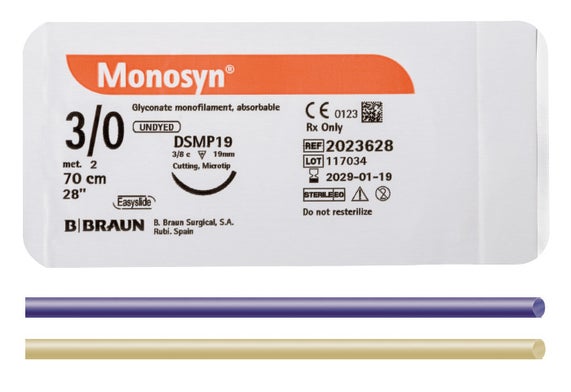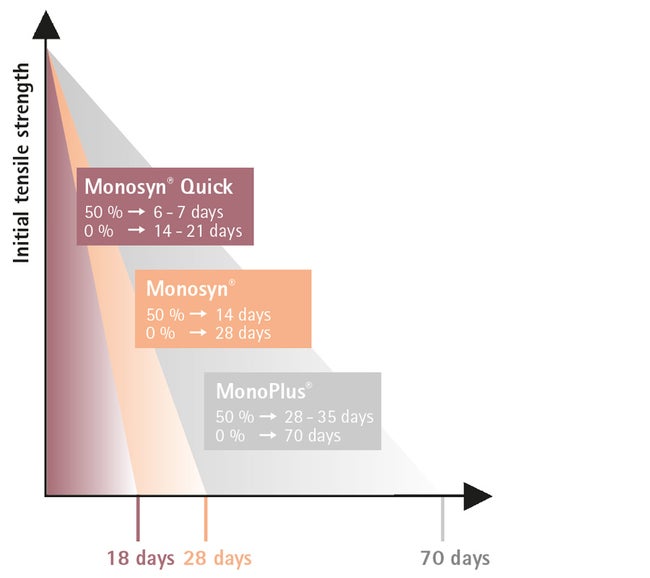The standard in soft tissue surgery
Monosyn® is particularly suitable for applications in which monofilament, synthetic, mid term tear-resistant, absorbable suture materials are used. For the universal use in veterinary soft tissue surgery. Monosyn® is therefore very well suited as a standard suture material in veterinary clinics and practices and is a real all-rounder.
Indications
- Gynaecology, urology, gastro. tract
- Skin, mucosa
- Sub- and intracutaneous sutures
Properties and features
- Wide indication field
- High knot pull tensile strength
- For universal use in soft tissue surgery and intracutaneous sutures
- Wide range of needle-thread combinations
| Structure: | Monofilament, uncoated |
| Chemical composition: | Gylconate |
| Diameter: | USP 7/0 - USP 2 |
| Colour: | undyed, dyed |
| Absorption time: | ~ 14 days |
| Knot tensile strength retention: | ~ 14 days p. i. 50 % |
| Mass absorption: | ~ 60 - 90 days |
The monofilament advantages
- The monofilament sutures appear to have the lowest infection promoting effects [1-4]
- Compared with braided multifilament sutures, absorbable monofilaments exhibit less tissue drag and cause less tearing because of their smooth surfaces [5]
Tensile strength retention of the B. Braun synthetic suture for fast healing tissues
Monosyn® Quick: Short term absorbable suture for fast healing tissues.
Monosyn®: Mid term absorbable suture for soft tissue approximation.
MonoPlus®: Long term absorbable suture designed for slow healing tissues.
B. Braun offers a comprehensive synthetic absorbable monofilament portfolio.
Related services and information
Related documents
[1] Mangram AJ, Horan TC, Pearson ML, Silver LC, Jarvis WR. Guideline for Prevention of Surgical Site Infection, 1999. Centers for Disease Control and Prevention (CDC) Hospital Infection Control Practices Advisory Committee. Am J Infect Control. 1999;27(2):97-132.
[2] Choi HJ, Chae HD. Comparison of E. Coli infiltration between new synthetic absorbable sutures. J Korean Surg Soc. 2009;77(1):1-6.
[3] Buresch A, Van Arsdale A, Ferzli M, Bernstein P, Garry D, Ngai I. Comparison of subcuticular suture type in post-cesarean wound complications: A randomized controlled trial American Journal of Obstetrics and Gynecology. 2017;216:1 Supplement 1 (S25).
[4] Won H-S, Lee S-W, Kim Y-M, Kim A. Clinical usefulness and safety of the anti-bacterial coated multi lament suture (Vicryl Plus®) and mono lament suture (Monosyn®) in hysterectomy BJOG: An International Journal of Obstetrics and Gynaecology. 2012;119 SUPPL. 1 (44)
[5] Im JN, Kim JK, Kim HK, Lee KY, Park WH. Characteristics of novel monofilament sutures prepared by conjugate spinning. J Biomed Mater Res B Appl Biomater. 2007;83(2): 499-504.



